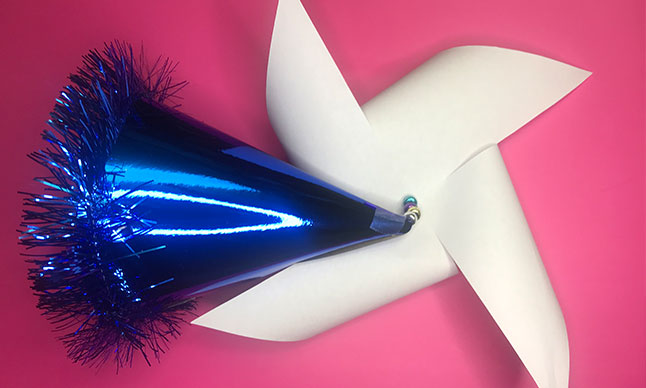Make a Pinwheel Hat
Transform kinetic energy to make your pinwheel move
- All
- Things to Make
- Experiments

What you’ll need:
- A 21.6 x 21.6-cm sheet of paper (or use the printable template)
- Scissors
- A pencil
- 1 paperclip
- 8 small beads
- A party hat
- A ruler
- Tape


Activity setup:
- Fold the paper diagonally from the top-left corner to the bottom-right corner to create a triangle. Unfold the paper and do the same thing from the top-right corner to the bottom-left corner. Unfold the paper again, and then use your pencil to mark a dot in the centre of the paper where the creases meet.
- Starting at one corner, cut the paper along the crease until you are about 2.5 cm from the centre dot. Repeat for the other three corners to create four flaps.
- On the top flap, mark a dot in the corner near the edges of the paper. Repeat this for the other three flaps so that all four corners are marked with a dot.
- Bend the paperclip open to create a straight line. Then, fold one end back to make a small loop towards the end of the straightened clip.
- Thread a bead onto the paperclip.
- Poke the paperclip through the back of your paper where you've marked a corner dot.
- Leaving the paper flap threaded onto the paperclip, work clockwise around the paper to poke the paperclip through the remaining three dots.
- Thread three beads onto the paperclip.
- Poke the paperclip through the dot in the centre of the template. Add four more beads.
- Fold the remaining length of the paperclip down at a right angle to secure the beads.
- Tape the paperclip to the top of the party hat on the front-hand side. Your pinwheel hat is complete!
- Put your hat on and move around. What happens to the pinwheel when you walk? What about when you run or jump?
Try this!
Try using different types and sizes of paper to create your pinwheel, like newspaper, giftwrap or stock paper. Which one spins the best? Keep in mind that if your paper is too large, it will hit the party hat as it spins.
Grab a fan and ask a helper to join you. Wearing your pinwheel hat, stand in the middle of a room, close your eyes and ask the helper to walk around the perimeter of the room while holding the fan. What happens to the pinwheel when you stand still? What about when you face the direction of the wind from the fan? Try holding out your arms—does this make it easier to detect the direction of the wind?

How does it work?
When you move, you generate kinetic energy. This energy pushes the flap of the pinwheel on the hat, causing it to spin. If you move faster, the pinwheel rotates faster. If you slow down, so does the pinwheel.
Wind turbines work in a similar way. These machines use the kinetic energy of wind to generate electricity. The blades of a wind turbine are attached to a rotor, which is connected to a generator via a driveshaft. The wind spins the blades, which spin the rotor, which then spins the generator. The generator contains magnets and metal coils. When it spins, it generates high-voltage electricity.
Each wind turbine has a yaw drive that allows the turbine to rotate. It also has a wind vane, which sends information about the wind speed and direction to the yaw system. This allows the turbine to change direction to face the wind so that it can generate as much electrical energy as possible.
The electricity generated by the wind turbine travels through transmission lines to a transformer station, which lowers the voltage of the electric current so that we can safely use the electricity in our homes.